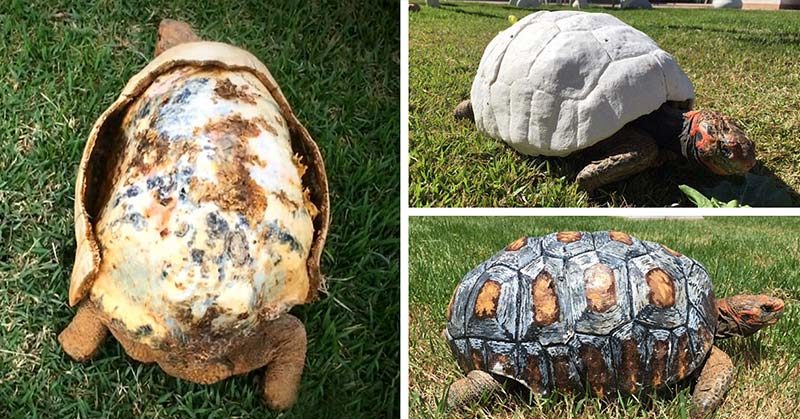An adorable tortoise named Freddy lost her shell in a forest fire in Brazil, and became the first ever tortoise with a 3D-printed prosthetic shell.
Fred is a survivor, of not just of the fire, but also of two bouts of pneumonia and 45 days without food. By then, a volunteer group called the ‘Animal Avengers’ found her in bad shape, as they described: “A very critical situation, almost in death, barely moved.” [1]
However, their ranks included a 3D designer and access to a 3D printer.
Tortoise Gets a New Shell From a 3D Printer
“When we saw the animal in that state, we said ‘Wow! It looks like Freddy Krueger’,” veterinarian Rodrigo Rabello.
Freddy Krueger is the villain in the 1968 slasher A Nightmare on Elm Street, with a burned and disfigured face. Comes to show what sort of state the tortoise was found in.
“The tortoise Freddy was found alongside a road in early 2015. It had been the victim of a fire, and its hull caught fire, losing 85 percent of its structure,” Cicero Moraes said. [2]
Fortunately, the Animal Avengers included a volunteer, Moraes, who was a 3D designer. So the team — which involved dental surgeon Paul Miamoto, and four veterinarians, Roberto Fecchio, Rodrigo Rabello, Sergio Camargo, and Matheus Rabello — set out to heal Freddy and create the world’s first 3D-printed tortoiseshell.
How They Built Freddy’s Shell
Freddy had only 15% of her natural shell left, and it continued to shed over several months, which created a problem for the team. They decided to virtually reconstruct what her shell should look like with photos of her and healthy tortoises.
“It took about 40 photos [to build a model and reconstruct the shell]. We took a healthy animal, took the same 40 photos, reconstructed that animal in 3D and put it into the computer,” said graphic designer Cicero Moraes.
They designed four individual sections intended to fit together like jigsaw puzzle pieces around Freddy. The volunteers used corn-based plastic, which costs about $36 a kilogram. The printing took 50 hours to complete. That’s how solid and sound Freddy’s shell is.
Once they fitted the shell onto Freddy, they painted it to match the typical patterns on a tortoiseshell. The paint offered some challenges. It had to stain permanently, not wear away the shell, or damage it in any way. Then they got Brazilian artist Yuri Caldera to decorate it.
Surgery was conducted to correctly fit the shell to the tortoise, and now Freddy enjoys full mobility and protection. After the work of Caldera, she blends in with her kin.
A New Chapter in Veterinary Prosthetics
Freddy lives with Rabello and is expected to have a heathy, long life. This 3D-printed shell was fitted five years ago, but its impact hasn’t ended.
“This is a mark in veterinary medicine,” Rabello said. “From now on we will have a new age. ‘Specially when it comes to wild animals.”
This technology has the potential to save animals in a way that hadn’t been realized before. For instance, the Animal Avengers used 3D printing to create artificial beaks for a parrot, a goose, and three toucans. These birds would have been euthanized if not for their innovative thinking.
“It’s a total satisfaction, we’ll always strain to save a life, no matter whose,” surmised Rabello. [3]
Read: 12 Times Wild Animals Actually Saved Humans
Other Animals with 3D-Printed Limbs
Mr. Stubbs
Mr. Stubbs the Alligator lacked a large section of his tail when an Arizona highway patrolman found him being illegally transported in a tractor-trailer. A missing tail can cause major issues for alligators, such as lack of balance on land and inability to properly propel themselves through the water.
The Herpetological Society contacted the CORE Institute and its sister nonprofit organization, the More Foundation, to wish for a solution for Mr. Stubbs.
“Certainly, this was the first time we’d had a request for an alligator,” says Marc Jacofsky, executive director of research and education at the MORE Foundation. “The motto of our organization is ‘keep life in motion,’ and I didn’t see anywhere where it says human life only.”
The researchers took a mold of Mr. Stubbs and of a health alligator of a similar size. Then they used computer software to create the tail and it took 150 hours to print. After $1,000 worth of materials, a new tail made of a touch silicone material was fitted for Mr. Stubbs.
Keating
Keating, a greyhound-boxer mix, wore a hand-turned peg leg, like a pirate. However, the Miller’s, his adoptive family, heard about 3D-printing prosthetics. In July 2019, prosthetics instructor Rick Sevier helped them create a blue and black leg with the pup’s name of it.
Keating is now a certified therapy dog and enjoys his new leg, even completing a 3-mile turkey trot with his owner.
Felix
Felix the sheep came to the Woodstock Farm Sanctuary in High Falls after a predator bit off a large section of his back leg. He was able to hobble around on three legs, but this caused strain onto these limbs. So with the help from SUNY New Paltz researchers, Felix received a 3D-printed leg.
Felix now lives a happier life, fully able to keep up with his friends in the sanctuary. [4]
Keep Reading: Meet the Frostbitten Cat That Has Become the First in the World to Receive Four Prosthetic Limbs
- “Injured Tortoise Gets A Hand-Painted 3D-Printed Shell.” Inside Edition. March 21, 2016
- “Tortoise Burned in Fire Gets Custom 3-D-Printed Shell.” Catherine Thorbecke. ABC News. May 23, 2016
- “Adorable Tortoise Receives a 3D-Printed Shell After Being Burnt in a Fire.” Fiona MacDonald. Science Alert. May 24, 2016
- “3D printing limbs gives pets the mobility they deserve.” Erin Carson. CNet. April 17, 2020

